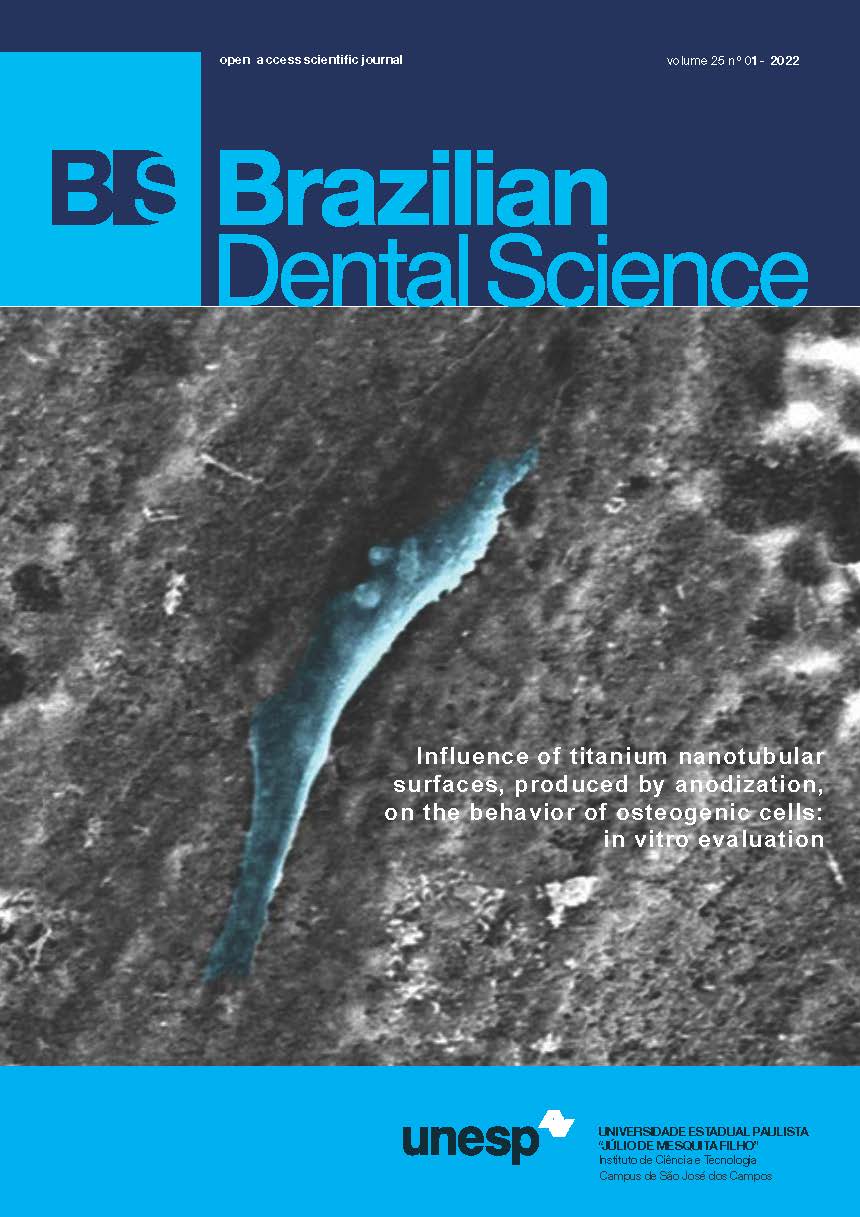Effect of whitening mouthrinses on color change of stained resin composites
DOI:
https://doi.org/10.4322/bds.2022.e2773Resumo
Objective: The present study compared the effect of whitening mouthrinses (WM) on the color change of stained
resin composites (RC). Material and Methods: Cylindrical specimens (6mm-diameter and 1mm-thickness)
were prepared with the following RC (n=60/group): Filtek Z350XT (Z350- methacrylate-based), Admira Fusion
(AD- ormocer-based), TPH3 (TPH- methacrylate-based), and Beautifil II (BII- giomer/methacrylate-based).
The initial color was assessed with reflectance spectrophotometer using CIE L*a*b* system. The specimens
were immersed in staining broth during 14 days, submitted to color evaluation (E1) and randomly allocated
in 4 subgroups (n=15), according to WM adopted: Listerine Whitening (LW-2% hydrogen peroxide), Plax
Whitening (PW-1.5% hydrogen peroxide), Bromelain/papain (BP-experimental solution), and Deionized water
(DW-negative control). The whitening cycle consisted of RC immersion in WM for 1 min and in artificial saliva
for 30 min, simulating 12 weeks, and final color assessment was performed (E2). Color change data were
analysed by ANOVA and Tukey’s tests (a=5%). Results: After staining, TPH showed the lowest E1 values
and Z350 showed the highest color change (p=0.001). The whitening effect promoted by LW was significantly
higher than color alteration obtained with PW (E2), and BII showed the highest color change values (E2) after
whitening cycle. Conclusion: LW exhibited the greatest whitening potential on stained RC, mainly with the
Giomer (Beautifill II) and the Ormocer-based (Admira Fusion) materials. Bromelain/papain solution showed
no whitening effect on stained RC.
KEYWORDS
Giomer; Hydrogen peroxide; Ormocer; Resin composite; Whitening mouthrinses.
Downloads
Downloads
Publicado
Versões
- 2022-03-29 (2)
- 2022-02-04 (1)
Como Citar
Edição
Seção
Licença
TRANSFERÊNCIA DE DIREITOS AUTORAIS E DECLARAÇÃO DE RESPONSABILIDADE
Toda a propriedade de direitos autorais do artigo "____________________________________________________________________" é transferido do autor(es) para a CIÊNCIA ODONTOLÓGICA BRASILEIRA, no caso do trabalho ser publicado. O artigo não foi publicado em outro lugar e não foi submetido simultaneamente para publicação em outra revista.
Vimos por meio deste, atestar que trabalho é original e não apresenta dados manipulados, fraude ou plágio. Fizemos contribuição científica significativa para o estudo e estamos cientes dos dados apresentados e de acordo com a versão final do artigo. Assumimos total responsabilidade pelos aspectos éticos do estudo.
Este texto deve ser impresso e assinado por todos os autores. A versão digitalizada deverá ser apresentada como arquivo suplementar durante o processo de submissão.




























